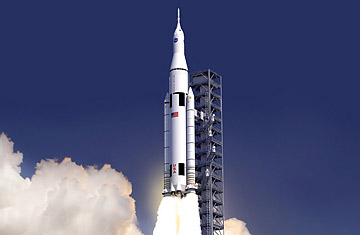
An artist's rendering of the Space Launch System, NASA's advanced heavy-lift launch vehicle that will provide an entirely new capability for human exploration in space
(2 of 2)
And that new path? A booster made up of the J-2X, the shuttle main engines, and, in the early iterations at least, the shuttle solids. "Yes," says former NASA administrator Michael Griffin, who was in charge during the Bush era, "this is one of the several close variants of Ares V that we studied."
O.K., so there's a little sleight of hand in the official press statements. But if the earlier design was a good one — and it was — what's the problem with admitting as much and returning to it? Nothing, provided the thing actually gets built — and the odds are uncertain at best.
Start with the institutional fecklessness that has plagued Washington and, to a lesser extent, the space agency itself since the end of the Apollo program. The original lunar program spanned the terms of four Presidents and seven Congresses, and while they argued over budget issues and long-term goals, they kept the moon firmly in sight. The decades since, by contrast, have been defined by start-stop projects that make the worst possible use of public funds and patience. Spacecraft are partly designed and partly built, and billions of dollars are spent, then the winds — and the parties in charge — change, and the plans are torn up.
While such attention-deficit disorder on space policy has afflicted every Administration from Nixon through Obama, the current White House has a particular challenge, selling big-ticket space spending in an era of penny-pinching and deficit wars. Bolden led with his chin on that one, promising: "This launch system will create good-paying American jobs." Indeed it will, but paying those workers and building the booster will cost a lot of money — up to $18 billion over the next six years. NASA believes it has that matter fairly well in hand.
"The costs are pretty much under control," says William Gerstenmaier, NASA's associate administrator for space operation who is in charge of human exploration. "We've put this together to make sure we can accommodate small budget changes over the years. The architecture and design have as low a technical and development risk as possible."
Even if that's true, in the best-case scenario the new SLS would not fly before 2017, and that would be only a smaller version with a 70-metric-ton lift. Still, that would be big enough to launch a crew on a lunar-orbital mission by 2021. The heavy-lift version with the completed J-2X won't come until 2025 at the earliest, assuming no increases in NASA's budget — and obviously no cuts either. Will the project survive the years? In an interview about the new booster with the New York Times, space-policy consultant James Muncy bleakly predicted no: "Yes, there will be budget cuts. Yes, it will be stretched out. Yes, it will have problems. Yes, it will fall apart."
NASA is having none of that, but it's tempering its predictions all the same. "We're going to give this a good run," is as far as Gerstenmaier would go.
For now, at least, the geeks can dream. While the NASA of the 21st century doesn't always deliver the engineering goods, it does do a fantastic job of showing how those goods would look in action — as a new SLS video on the NASA website illustrates. If policymakers can keep their focus and do their jobs, the clip is a thrilling glimpse into a promising future. If they can't, it's one more sad look at a goal deferred.
